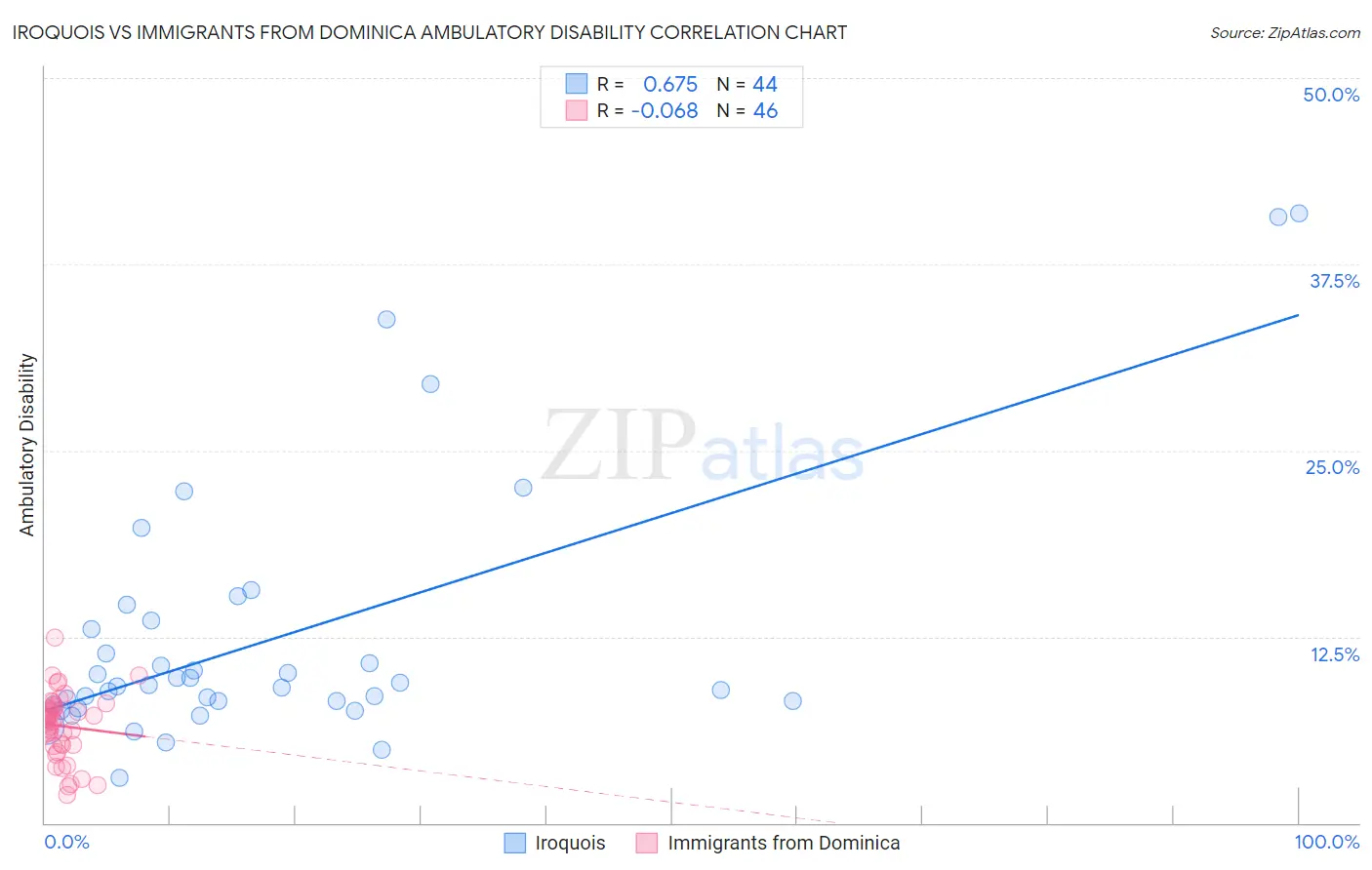Iroquois vs Immigrants from Dominica Ambulatory Disability
COMPARE
Iroquois
Immigrants from Dominica
Ambulatory Disability
Ambulatory Disability Comparison
Iroquois
Immigrants from Dominica
7.1%
AMBULATORY DISABILITY
0.0/ 100
METRIC RATING
306th/ 347
METRIC RANK
6.9%
AMBULATORY DISABILITY
0.0/ 100
METRIC RATING
289th/ 347
METRIC RANK
Iroquois vs Immigrants from Dominica Ambulatory Disability Correlation Chart
The statistical analysis conducted on geographies consisting of 207,272,935 people shows a significant positive correlation between the proportion of Iroquois and percentage of population with ambulatory disability in the United States with a correlation coefficient (R) of 0.675 and weighted average of 7.1%. Similarly, the statistical analysis conducted on geographies consisting of 83,791,064 people shows a slight negative correlation between the proportion of Immigrants from Dominica and percentage of population with ambulatory disability in the United States with a correlation coefficient (R) of -0.068 and weighted average of 6.9%, a difference of 2.8%.

Ambulatory Disability Correlation Summary
| Measurement | Iroquois | Immigrants from Dominica |
| Minimum | 3.0% | 1.9% |
| Maximum | 40.9% | 12.5% |
| Range | 37.9% | 10.6% |
| Mean | 12.5% | 6.5% |
| Median | 9.2% | 6.8% |
| Interquartile 25% (IQ1) | 8.0% | 5.2% |
| Interquartile 75% (IQ3) | 13.3% | 7.8% |
| Interquartile Range (IQR) | 5.2% | 2.6% |
| Standard Deviation (Sample) | 8.7% | 2.2% |
| Standard Deviation (Population) | 8.6% | 2.2% |
Demographics Similar to Iroquois and Immigrants from Dominica by Ambulatory Disability
In terms of ambulatory disability, the demographic groups most similar to Iroquois are Spanish American (7.1%, a difference of 0.26%), Immigrants from Micronesia (7.0%, a difference of 0.53%), Immigrants from Cabo Verde (7.0%, a difference of 0.82%), African (7.0%, a difference of 1.2%), and Immigrants from Armenia (7.0%, a difference of 1.2%). Similarly, the demographic groups most similar to Immigrants from Dominica are Scotch-Irish (6.9%, a difference of 0.030%), West Indian (6.9%, a difference of 0.12%), Nonimmigrants (6.9%, a difference of 0.14%), Cheyenne (6.9%, a difference of 0.19%), and U.S. Virgin Islander (6.8%, a difference of 0.41%).
| Demographics | Rating | Rank | Ambulatory Disability |
| U.S. Virgin Islanders | 0.0 /100 | #287 | Tragic 6.8% |
| Immigrants | Nonimmigrants | 0.0 /100 | #288 | Tragic 6.9% |
| Immigrants | Dominica | 0.0 /100 | #289 | Tragic 6.9% |
| Scotch-Irish | 0.0 /100 | #290 | Tragic 6.9% |
| West Indians | 0.0 /100 | #291 | Tragic 6.9% |
| Cheyenne | 0.0 /100 | #292 | Tragic 6.9% |
| Immigrants | St. Vincent and the Grenadines | 0.0 /100 | #293 | Tragic 6.9% |
| Cape Verdeans | 0.0 /100 | #294 | Tragic 6.9% |
| Crow | 0.0 /100 | #295 | Tragic 6.9% |
| Alaskan Athabascans | 0.0 /100 | #296 | Tragic 6.9% |
| French American Indians | 0.0 /100 | #297 | Tragic 6.9% |
| Immigrants | Grenada | 0.0 /100 | #298 | Tragic 6.9% |
| Puget Sound Salish | 0.0 /100 | #299 | Tragic 6.9% |
| Marshallese | 0.0 /100 | #300 | Tragic 6.9% |
| British West Indians | 0.0 /100 | #301 | Tragic 7.0% |
| Immigrants | Armenia | 0.0 /100 | #302 | Tragic 7.0% |
| Africans | 0.0 /100 | #303 | Tragic 7.0% |
| Immigrants | Cabo Verde | 0.0 /100 | #304 | Tragic 7.0% |
| Immigrants | Micronesia | 0.0 /100 | #305 | Tragic 7.0% |
| Iroquois | 0.0 /100 | #306 | Tragic 7.1% |
| Spanish Americans | 0.0 /100 | #307 | Tragic 7.1% |